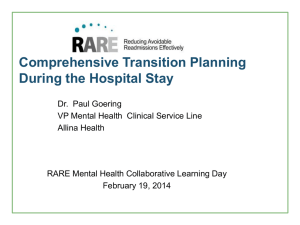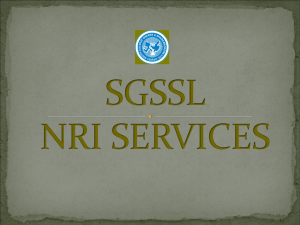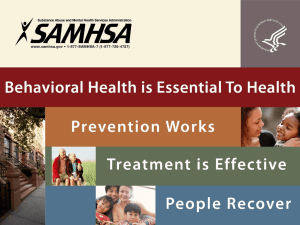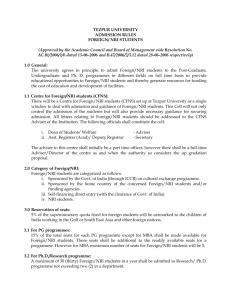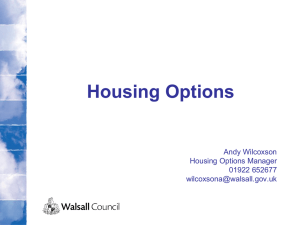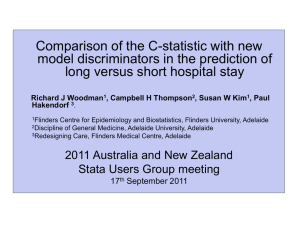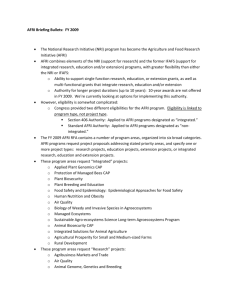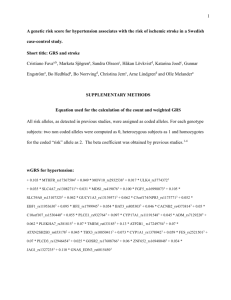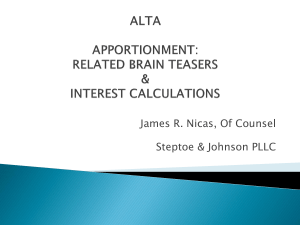View this presentation. - National Association of State Mental Health
advertisement
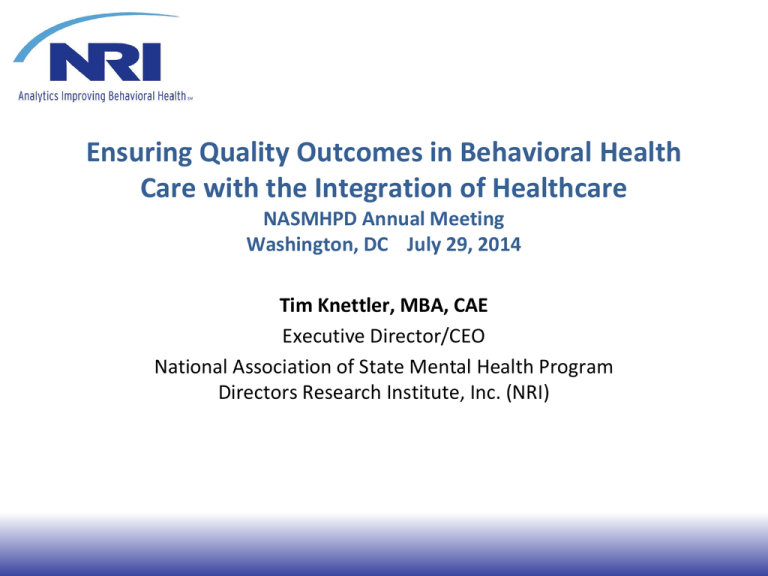
Ensuring Quality Outcomes in Behavioral Health Care with the Integration of Healthcare NASMHPD Annual Meeting Washington, DC July 29, 2014 Tim Knettler, MBA, CAE Executive Director/CEO National Association of State Mental Health Program Directors Research Institute, Inc. (NRI) Table of Contents • NRI’s New Initiatives • 2013 State Profiles • 2014 Case Studies of Early Innovator States o Health/Behavioral Health Integration • Assessing two Outcomes for Consumers Served by State Mental Health Agencies: (1) Improving Competitive Adult Employment & (2) Reducing Homelessness • Psychiatric Hospital Reporting Performance Requirements – The New Landscape 3 New NRI Initiatives Strategic Planning and New Initiatives NRI Vision, Mission, Values • Vision: No person's life will be limited by mental illness or addiction. • Mission: NRI products and services support and enable actions that improve mental health and wellness. • Values: NRI pursues its mission according to the following core values: o Lack of bias o Life enhancing value o Insight 4 New NRI Initiatives NRI is working with its Board and States to develop new initiatives to meet State needs 1. Pilot/Develop an Integrated Medicaid Claims and State Behavioral Health Agency Data System 2. Customized State Reports to help SBHAs with budgeting, planning, operations and policy 3. Help SBHAs respond to critical incidents and legal actions by accessing the latest state and national data customized to state needs 4. Assessing the Premature Mortality of SBHA Clients 5. Psychiatric Hospital Analytics/Consultations to comply with new requirements and Improve Outcomes 5 2013 State Profiles: Funding and Characteristics of SMHAs and SSAs • New SAMHSA publication that focuses on how SMHAs and SSAs are organized, financed and major policy initiatives o Jointly produced by NRI, NASADAD, and Truven Health Analytics • Focus on SMHA and SSA activities to integrate health-BH care and impact of ACA implementation • Report will be available on the SAMHSA website in August, 2014 6 2014 State MH Profiles: Case Studies of Early Innovator States • 1. 2. 3. Activities in 3 major policy areas— Health-Behavioral Health Integration Implementing Evidence-Based Practices Changing SBHA Business Practices (including EHRs) o How Parity and ACA impact SBHA activities? o Effects on State General Funds and MH Block grants? 7 Health-Behavioral Health Integration: Early Results Factors that Impact Health-BH Integration: • Medicaid Support: Support for health integration initiatives from State Medicaid Agencies was a key to successful integration across the early innovator states. • State Leadership: Identifying a common cause, issue, report, or topic to rally state leadership around a focus on behavioral health was seen as vital. 8 Health-Behavioral Health Integration: Early Results (continued) Factors that Impact Health-BH Integration: • Long Term Planning: a long-term planning effort to comprehend the complexities of integration of system changes (can easily take from 1.5 to 3 years). • 42 CFR Part 2: limits the sharing of patient information on substance use clients restricts state’s ability to share substance use treatment data with primary care providers and HIEs. 9 Focus on Two SAMHSA MH National Outcome Measures (NOMS) • Improving Competitive Employment • Reducing Homelessness Uses information from: • the Annual CMHS/SAMHSA Uniform Reporting System (which collects information on 7.2 million persons served by SMHAs each year) • MH-Client Level Data: de-identified client level data from SMHAs 10 Competitive Employment of Adults in the SMHA System: 2013 Employed 17% Not In Labor Force 53% Unemployed 30% 26.8% of all SMHA Adult Consumers had an unknown employment status in 2013, an improvement from 30% in 2003 Source: 2013 SAMHSA Uniform Reporting System (URS) 11 Percent of SMHA Mental Health Consumers Competitively Employed: 2003 to 2013 25% 20% 15% 23.0% 21.0% 21.0% 22.0% 21.0% 21.0% 19.0% 16.9% 20.0% 18.1% 17.0% 10% 5% 0% 2003 2004 2005 2006 2007 2008 2009 2010 2011 2012 2013 12 Adult Employment: Diagnostic Group 2012, Employed At Start of Reporting Period , Ages 18-64 Employed 25.0% 20.0% 19.7% 16.1% 15.6% 15.2% 15.0% 10.9% 10.9% 10.0% 8.1% 5.0% 0.0% Anxiety Disorders Personality Disorders Bipolar Disorders ADHD Delusional and Other Psychoses Intellectual Disability Schizophrenia Employed Total N=1,344,579 (59.8%); missing=902,982 (40.2%) 13 Employment Change During 2012 from T1 to T2 90% 80% (For Clients Ages 18-64 who were Employed at T1) 76.6% 70% 60% 50% 40% 30% 20% 11.2% 12.2% 10% 0% Maintained Employment from T1 Moved from Employed at T1 to to T2 Unemployed at T2 N=701,581 2014 NASMHPD Commissioners Meeting: July 29, 2014 Moved from Employed at T1 to Not In Labor Force at T2 14 Living Situation of Adult Consumers: 2012 Foster Home, 0.7% Residential Care, 4.9% Crisis Residence, 1.4% Residential Treatment Center, 0.1% Institutional Setting, 3.9% Private Residence, 78.7% Jail (Correctional Facility), 2.3% Homeless (Shelter), 4.0% Other, 4.1% 15 Homelessness Rate: Age & Gender 2012, At Start of Reporting Period 10% Male 9% Female 8% Homelessness Rate at Each Age 7% 6% 5% 4% 3% 2% 1% 0% 5 10 15 20 25 30 35 40 45 50 Client Age 55 60 65 70 75 80 85+ Male: N=1,070,796 (68.0%); missing=503,423 (32.0%) Female: N=1,143,532 (69.0%); missing=512,679 (31.0%) 16 Homelessness Rates: Major Diagnostic Groups 2012, At Start of Reporting Period, Ages 18+ Percent of Each Diagnostic Group That Were Homeless 10% 9% 8.8% Male Female 8% 6.7% 7% 6% 6.6% 5.4% 5.3% 5.2% 5% 4.5% 4% 3.3% 3.2% 2.7% 3% 3.2% 3.1% 2.6% 2.4% 1.8% 2% 2.1% 1% 0% Delusional and Other Psychoses Bipolar Disorders Depressive Disorders Personality Schizophrenia Disorders Total N=1,508,607 (63.6%); missing=864,935 (36.4%) Anxiety Disorders ADHD Intellectual Disability 17 Percent of Persons Homeless At T1 Living Situation at T2 60% Living Situation at T2 (End of Year or Discharge) for SMHA Adult (age 18+) Consumers who were Homeless at T1 (Admission/Start of Year) 51.9% 50% 40% 33.8% 30% 20% 10% 4.6% 7.4% 2.3% 0% Homeless at T2 Total N=1,054,951 Homelike setting at T2 Residential Care at T2 Institution/Jail/Prison at T2 Other Residential Status at T2 18 Living Situation at T2 (End of Year or Discharge) for SMHA Adult (age 18+) Consumers who were Living in a Homelike Setting at T1 (Admission/Start of Year) Percent of Persons Living in a Homelike Setting At T1 Living In Situation at T2 100% 93.3% 90% 80% 70% 60% 50% 40% 30% 20% 10% 1.0% 1.1% Homeless at T2 Homelike setting at Residential Care at T2 Institution/Jail/Prison T2 at T2 0% Total N=1,054,951 .8% 3.8% Other Residential Status at T2 19 Psychiatric Hospital Reporting Performance Requirements – The New Landscape CMS Requirements IPFQR • IPFQR program: Inpatient Psychiatric Facility Quality Reporting program o Free-standing psychiatric hospitals and psychiatric units (IPF) (approximately 1800) o Measures apply to the Medicare certified units reimbursed under the IPF Prospective Payment System (PPS) o Independent of accreditation o Failure to report quality measure results in a 2 percentage point reduction in the hospital’s annual payment update determination 21 Requirement – FFY2014 - Completed • Oct 2012 – Mar 2013 data on HBIPS 2 -7 o HBIPS: Hospital Based Inpatient Psychiatric Services core measure set. o Measure steward: The Joint Commission • 100% of NRI facilities met the requirement • 62 facilities lost 2 percentage points in their Annual Payment Update for not meeting the requirements (none of the NRI facilities lost revenue) 22 Current & Proposed CMS Reporting Requirements Reporting Requirements 16 14 12 10 Aggregate Count 8 Attestation 6 Quality Measures 4 2 0 2015 2016 2017 23 Requirements – Current and Future • FFY2015 o April 2013 – Dec 2013 data on HBIPS 2-7 • FFY2016 o Calendar 2015 data on HBIPS 2-7; SUB-1: Alcohol Use Screen. o FUH: Follow-up after hospitalization. (Note: this measures will be calculated by CMS based on Claims data) o Attestation: Is facility conducting a “Patient Experience of Care” survey o Possible New Attestation: What level of Electronic Health Record (EHR) the facility is using during transitions of care 24 Requirements – Current and Future • FFY2017 o Continuation of all previous measures o Proposed new measures: ‒ TOB1 – Tobacco Use Screen; TOB2 – Tobacco Use Treatment provided or offered, TOB2A – Tobacco Use Treatment provided ‒ IMM-2: Influenza Immunization for patients ‒ Influenza vaccination among health care personnel ‒ Aggregate Population and Sample Counts, by Medicare/Not Medicare, Age Group, Diagnostic group • Also undergoing testing/development o Screenings within 1 day of admission o All cause, any location readmission rate 25 The Joint Commission Requirements • Complete reporting o Underreporting patient-level records will be questioned and must be corrected o The Joint Commission has had patient-level data for HBIPS since the beginning (2008) o The Joint Commission data integrity process mirrors the CMS process, although CMS only receives aggregate data for IPF at this time • Accountability rate o Summary calculation across the HBIPS measure must be at least 85% o Failure to meet performance levels will result in a ‘Request for Improvement Action Plan’ during the triennial review 26 Assisting your hospitals with compliance • Know the rules, prepare to respond to proposed rulemaking • Ensure hospital commitment to meeting the performance expectation • Encourage moving beyond the minimum expectation to use the data/information to improve care and coordination with other providers • NRI – BHPMS resources include numerous reports to assist with quality initiatives and personal technical assistance 27 28 Contact Tim Knettler, MBA, CAE Executive Director/CEO www.nri-inc.org 3141 Fairview Park Dr., Suite 650 Falls Church, Virginia 22042-4539 Phone: (703) 738-8161 TKnettler@nri-inc.org Lucille Schacht, PhD Senior Director of Performance and Quality Improvement Phone: (703) 738-8163 lschacht@nri-inc.org Ted Lutterman Senior Director of Government and Commercial Research Phone: (703) 638-8164 tlutterman@nri-inc.org 29


